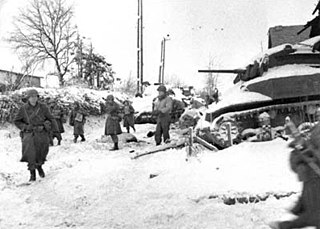
The Battle of the Bulge, also known as the Ardennes Offensive, was the last major German offensive campaign on the Western Front during World War II. The offensive was carried out from 16 December 1944 to 25 January 1945, towards the end of the war in Europe. It was launched through the densely forested Ardennes region between Belgium and Luxembourg.

Bastogne is a city and municipality of Wallonia located in the province of Luxembourg in the Ardennes, Belgium.

Anthony Clement "Nuts" McAuliffe was a senior United States Army officer who earned fame as the acting commander of the 101st Airborne Division defending Bastogne, Belgium, during the Battle of the Bulge in World War II. He is celebrated for his one-word reply to a German surrender ultimatum: "Nuts!"

The 10th Armored Division was an armored division of the United States Army in World War II. In the European Theater of Operations the 10th Armored Division was part of both the Twelfth United States Army Group and Sixth United States Army Group. Originally assigned to the Third United States Army under General George S. Patton, it saw action with the Seventh United States Army under General Alexander Patch near the conclusion of the war.

The 11th Armored Division was a division of the United States Army in World War II. It was activated on 15 August 1942 at Camp Polk, Louisiana and moved on 24 June 1943 for the Louisiana Maneuvers. Transferred then to Camp Barkeley, Texas on 5 September 1943, the division participated, beginning 29 October 1943, in the California Maneuvers and arrived at Camp Cooke California on 11 February 1944. The division staged at Camp Kilmer, New Jersey from 16 to 29 September 1944 until departing New York Port of Embarkation on 29 September 1944, arriving in England on 11 October 1944.

The siege of Bastogne was an engagement in December 1944 between American and German forces at the Belgian town of Bastogne, as part of the larger Battle of the Bulge. The goal of the German offensive was the harbor at Antwerp. In order to reach it before the Allies could regroup and bring their superior air power to bear, German mechanized forces had to seize the roadways through eastern Belgium. Because all seven main roads in the densely wooded Ardennes highlands converged on Bastogne, just a few miles away from the border with neighboring Luxembourg, control of its crossroads was vital to the German attack. The siege was from 20 to 27 December, until the besieged American forces were relieved by elements of General George Patton's Third Army.
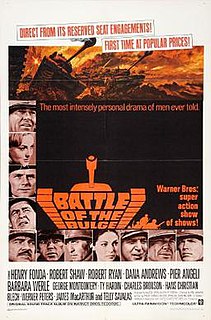
Battle of the Bulge is a 1965 American widescreen epic war film produced in Spain, directed by Ken Annakin, and starring Henry Fonda, Robert Shaw, Telly Savalas, Robert Ryan, Dana Andrews, and Charles Bronson. The feature was filmed in Ultra Panavision 70 and exhibited in 70 mm Cinerama. Battle of the Bulge had its world premiere on December 16, 1965, the 21st anniversary of the titular battle, at the Pacific Cinerama Dome Theatre in Hollywood, California.
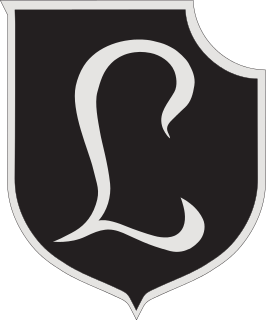
The Panzer-Lehr-Division was an elite German armoured division during World War II. It was formed in 1943 onwards from training and demonstration troops stationed in Germany, to provide additional armored strength for the anticipated Allied invasion of western Europe. On 4 April 1944, the division was officially designated as the 130th Panzer Division; however, it is usually referred to as the Lehr Division. It was the only Wehrmacht Panzer division to be fully equipped with tanks and with halftracks to transport its mechanized infantry. On several occasions it fought almost to destruction, in particular during Operation Cobra, and by the end of the war in Europe bore little resemblance to the unit that had originally been activated.

The 2nd Panzer Division was an armoured division in the German Army, the Heer, during World War II.

The 761st Tank Battalion was a separate tank battalion of the United States Army during World War II. The 761st was made up primarily of African-American soldiers, who by War Department policy were not permitted to serve alongside white troops; the U.S. military did not officially desegregate until after World War II. The 761st were known as the Black Panthers after their unit's distinctive insignia, which featured a black panther's head; their motto was "Come out fighting". The battalion received a Presidential Unit Citation for its actions. In addition, a large number of individual members also received medals, including one Medal of Honor, 11 Silver Stars and about 300 Purple Hearts.
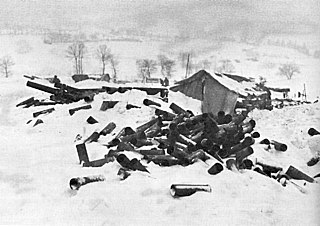
The Battle of Elsenborn Ridge refers to the northernmost German attacks during the Battle of the Bulge. The area from Elsenborn Ridge itself to Monschau was the only sector of the American front line attacked during the Battle of the Bulge where the Germans failed to advance. The battle centered on the boomerang-shaped Elsenborn Ridge east of Elsenborn, Belgium. In this region, Elsenborn Ridge marks the westernmost ridge of the Ardennes, rising more than 2,000 feet (600 m) above sea level; unlike the uplands further north, east and south, it has been extensively logged. West of Elsenborn Ridge, where the land descends in gentle hills to the cities of Liège and Spa, was a network of Allied supply bases and a well-developed road network. The Germans planned on using two key routes through the area to seize Antwerp and force a separate peace with the United States and Britain. Capturing Monschau, the nearby village of Höfen, and the twin villages of Rocherath-Krinkelt just east of Elsenborn Ridge, were key to the success of the German plans, and Hitler committed his best armored units to the area.
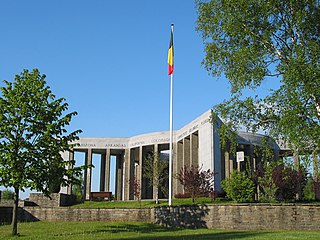
The Battle of the Bulge Monument formerly known as the Mardasson Memorial is a monument honoring the memory of American soldiers wounded or killed during World War II's Battle of the Bulge. Designed in the shape of a five-pointed American star, it is located near Bastogne in the Luxembourg province of Belgium. The first step toward the memorial was undertaken on July 4, 1946, with the presentation of some earth from the site to U.S. President Harry Truman. The dedication was on July 16, 1950.
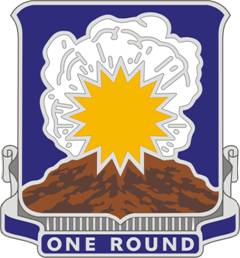
The 705th Tank Destroyer Battalion was a tank destroyer battalion of the United States Army active during the Second World War. It was originally formed from artillery elements of the 5th Armored Division, and its lineage is today perpetuated by the 75th Cavalry Regiment.

Al Murray's Road to Berlin is a British documentary television series about World War II, presented by Al Murray. The ten-episode series was produced for the Discovery Channel, and first broadcast in 2004. During the series, Murray travels across the Western Front in a restored Willys MB Jeep, covering the timeline from the Invasion of Normandy to the fall of Berlin, interviewing survivors and showcasing some of the equipment used.

Augusta Marie Chiwy was a Belgian nurse who served as a volunteer during the Siege of Bastogne in 1944. She worked with U.S. Army physician John Prior and with fellow Belgian nurse Renée Lemaire, treating injured soldiers during the Battle of the Bulge.

The Battle of Clervaux or the Battle for Clervaux was an opening engagement of the Battle of the Bulge that took place in the town of Clervaux in northern Luxembourg. It lasted from December 16 to 18, 1944. German forces encircled numerically inferior American forces, primarily from the 110th Regiment and the 109th Field Artillery Battalion, and quickly forced them to surrender. The battle has been referred to as the Luxembourg "Alamo".
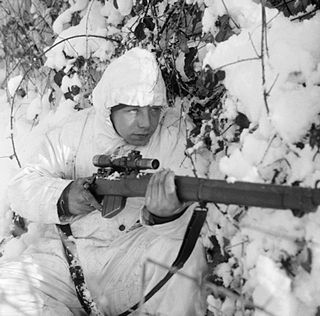
The Battle of Bure was part of the Battle of the Bulge, which lasted from 3 to 5 January 1945 during the final months of the Second World War. The battle was fought as part of the allied counterattack to rid the German held ground of the 'Bulge' which forced them on the defensive. British XXX Corps with British 6th Airborne Division attached was tasked with clearing the area East of Dinant, Rochefort, Grupont and Bure. In a tough battle Bure was secured after nearly three days of heavy fighting whilst Gupont and Rochefort were both cleared with little resistance and the advance continued.
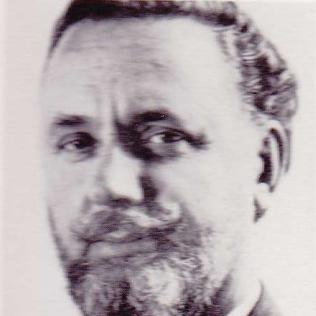
Peter Frederick Egerton Elstob was a British soldier, adventurer, novelist, military historian and entrepreneur. In his writing, he is best known for his lightly-fictionalized novel Warriors For the Working Day (1960) and his military history of the Battle of the Bulge, Hitler's Last Offensive (1971). He joined the Republican Army in the Spanish Civil War, and later served in the Royal Tank Regiment in World War II, in which service he was promoted to sergeant and was Mentioned in Dispatches. He joined International PEN in 1962 and served first as general secretary and later as vice-president for seven years during the 1970s, rescuing the organisation from financial failure; he also secured the future of the Arts Theatre Club in London in 1946. He prospered as an entrepreneur with a facial product called Yeast Pac, with several partners. In his obituary in The Guardian newspaper, Elstob was said to be
...one of those people born in the wrong century. With his charm and audacity, his passion for travel, and his love of risk-taking and financial gambles, he would have been more at home in the reign of Elizabeth I.

Liberation Route Europe is an international remembrance trail that connects the main regions along the advance of the Western Allied Forces toward the liberation of Europe and final stage of the Second World War. The route started in 2008 as a Dutch regional initiative in the Arnhem-Nijmegen area and then developed into a transnational route that was officially inaugurated in Arromanches on June 6, 2014, during the Normandy D-day commemorations. The route goes from Southern England through France, Belgium, Luxembourg, the Netherlands to Berlin in Germany, then extends to the Czech Republic and Poland. The southern route starts in Italy. As a form of remembrance tourism, LRE aims to unfold these Allied offensives of 1944 and 1945 in one narrative combining the different perspectives and points of view. By combining locations with personal stories of people who fought and suffered there, it gives visitors the opportunity to follow the Allied march and visit significant sites from war cemeteries to museums and monuments but also events and commemorations. In April 2019, Liberation Route Europe became a certified Cultural Route of the Council of Europe.

Cobra King is an American Sherman tank of World War II. During the Battle of the Bulge in December 1944, the Germans had attacked a weakly defended section of the Allied line and surrounded American forces in the town of Bastogne. Cobra King was the first tank to enter the Bastogne perimeter in relief of the besieged American 101st Airborne Division.





















